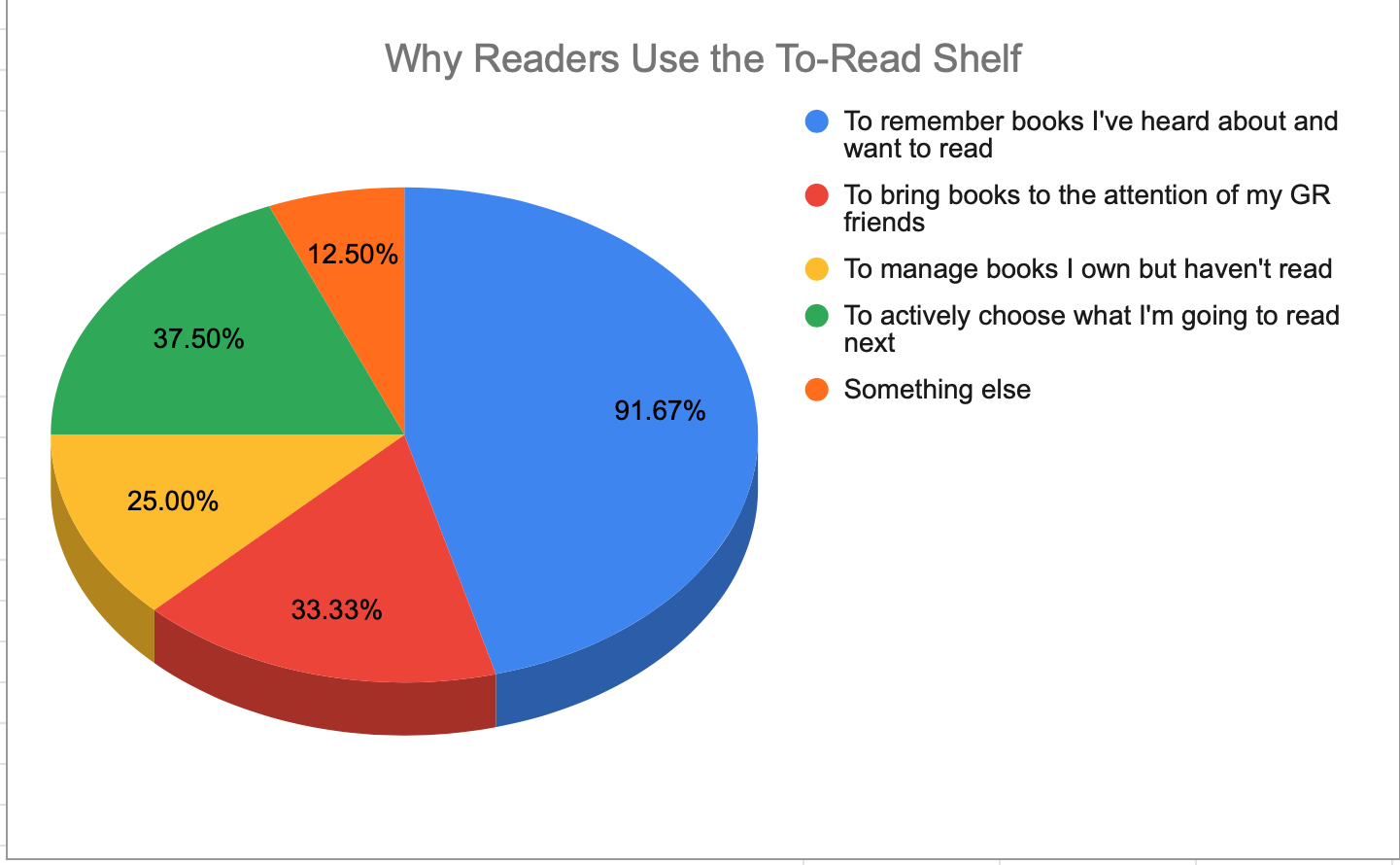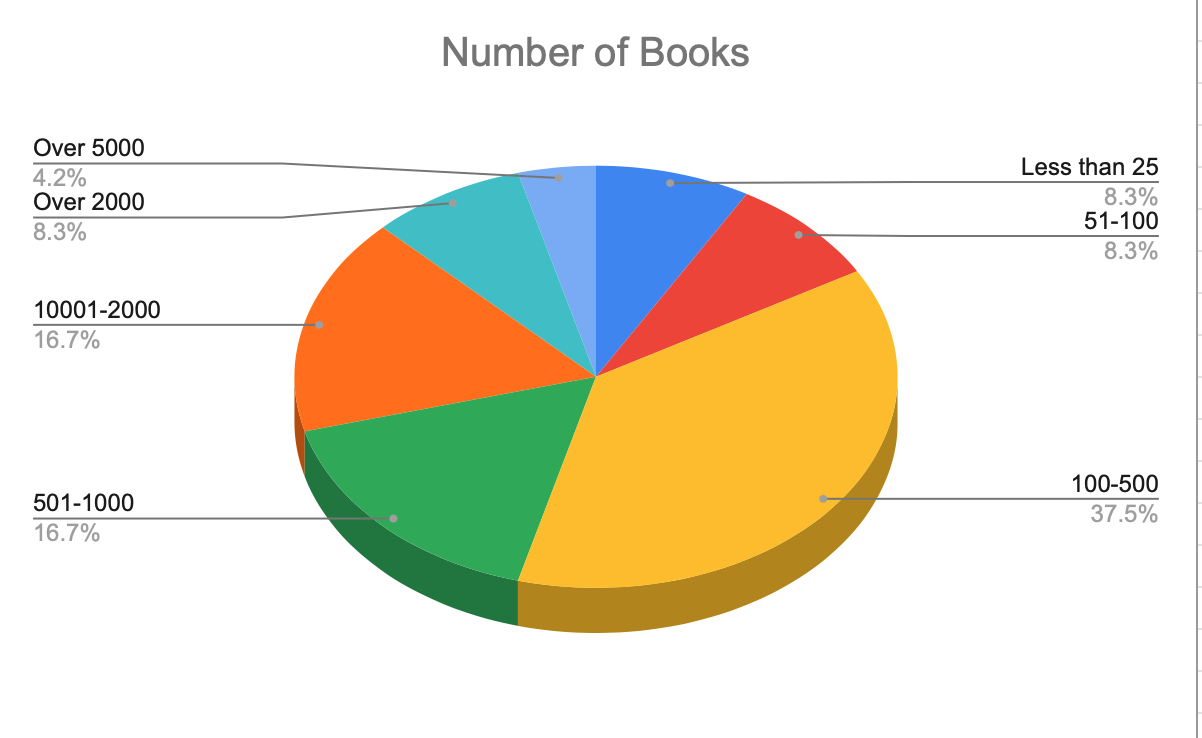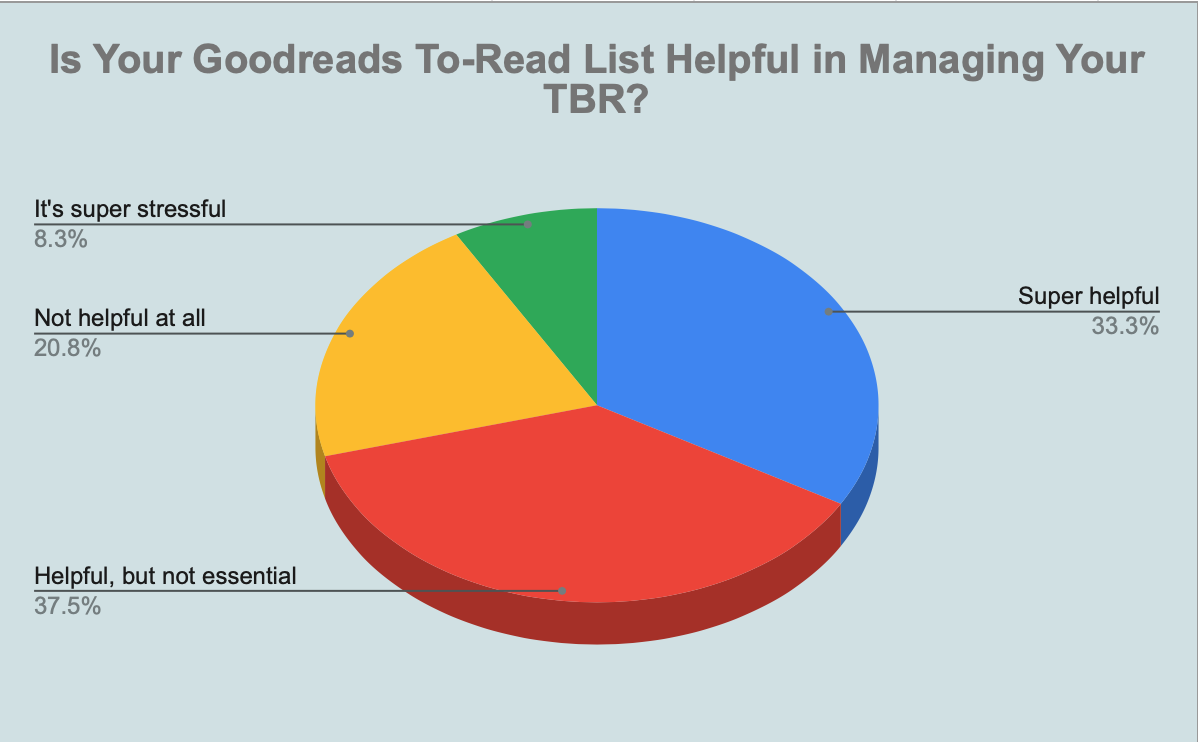My approach to using the Goodreads to-read shelf is one of many. I find it extremely useful, and I started to wonder: do folks with thousands of books on their to-read shelf also find it useful? How do different readers use this function? What purpose does it serve in their reading lives? How do people organize their TBRs, both on and off Goodreads? Is there an optimal way to utilize the Goodreads to-read shelf? Is it entirely dependent on the reader? Or is there evidence that smaller (or larger) TBRs are more useful? Is the to-read shelf a tool, or a source of stress? To find out, I surveyed 30 Book Riot contributors about their Goodreads habits. It’s a small sample size, but it revealed some fascinating information about how different readers manage their TBRs.
Who Uses the Goodreads To-Read Shelf
Let’s start with the basics. Of the readers I surveyed, 83% use the to-read shelf on Goodreads, while 17% aren’t on Goodreads, and use alternate methods to manage their TBRs. This about tracks with my non-scientific analysis of readers in general. I’d say at least half of my real-life reader friends are on Goodreads. I work as a bibliologist for Tailored Book Recommendations, and far more than half of my customers also have a Goodreads account. Say what you will about Goodreads, but it’s clearly prevalent in the bookish world. It’s interesting to note that of the 83% of Rioters who reported using the Goodreads to-read shelf, 63% also said they have other TBR lists as well. I’m also in this camp. In fact, I have nine separate TBRs, not including my Goodreads list. It turns out this is fairly common, and it makes sense: the to-read shelf on Goodreads is fairly clunky. It’s hard to make subcategories, for instance. It’s a useful tool for remembering books you don’t own and want to read (and, as we’ll see, this is the #1 reason the readers I surveyed use it), but it’s not so great for keeping track of owned books.
Why Readers Use the To-Read Shelf in the First Place
Let’s take a look at why readers use the to-read shelf. The biggest takeaway here is that most readers (91% of those I surveyed) use this function to keep track of books they’ve heard of and are interested in, but don’t own. The to-read shelf is designed for this. It’s easy to add a book while browsing through your feed, and it’s a useful way to keep track of all those unowned books you want to read. What’s more interesting to me is that, while 91% of respondents use the to-read shelf to remember books they want to read, only 37% use it to actively choose what they’re going to read next. This is what I use my to-read shelf for. When I’m ready to put new books on hold at the library, I scroll through the list and select what I’m in the mood for. It’s also why I keep my to-read list at under 100. Anything beyond that is too much to look at at once. I assumed there would be a correlation between the number of books on someone’s to-read shelf and whether or not they used it to actively pick books to read. And there is, sort of. No one I surveyed with more than 2000 books on their to-read shelf uses it to choose their next read. But the respondents who do use it this way have shelves ranging from 50 to 1,000 books. I can’t imagine scrolling through 1,000 books to choose my next read, but plenty of other people do just that! It’s interesting to note that only 37% of readers who use their to-read shelf to remember books they want to read use it for only that purpose. Most people use it for more than one reason. This is likely one of the reasons Goodreads remains so popular. It’s not perfect, but it can serve many purposes.
What Do Most Readers’ To-Read Shelves Look Like?
Number of Books
It appears that most readers like a happy medium. The majority of readers I surveyed have between 100 and 1,000 books on their to-read shelf (54%). I’m in the minority, with less than 100, but so are the readers with over 2,000. In general, the number of books on someone’s to-read shelf doesn’t seem to have much to do with how they use it. All the readers with over 2,000 books on their to-read shelf also have additional TBR lists, while none of the readers with less than 25 books on their to-read shelf do.
Limits
Only 30% of the readers I surveyed implement limits on how many books they add to their to-read shelf. Setting a limit of 100 books is one of the reasons I find my to-read shelf so easy to use. But setting limits, in general, has nothing to do with how useful readers find their to-read shelves. Among the readers who do set limits, there was an even split between there to-read shelves being helpful, not helpful at all, and stressful.
Custom Shelves
35% of readers with to-read shelves create their own custom shelves in addition to the standard one that Goodreads provides. Several respondents use “high priority” lists to sort out books they want to reader sooner rather than later. One reader sorts her to-read shelf into various categories: print ARCs, audiobooks, digital books, and print books. A few readers also report creating lists for books they own but haven’t read yet. Cassie says: “I have an ‘own’ shelf and an ‘arc own’ shelf so I can keep track of the books physically taking up space in my house. I also have genre categories so if I am in the mood for a romance, I can select both ‘romance’ and ‘own’ to see what books in those categories I have in my house that I should read.” I find all of these different strategies so fascinating. As soon as I buy a book, I immediately take it off my to-read shelf. I don’t want to have it listed in two places! But Cassie makes a good point — I can see how being able to sort your owned books by genre would be helpful.
Shelf Management
Culling Books
Most of the readers I surveyed (about 70%) have some kind of strategy for culling books from their to-read shelf. A few readers, like me, make this a regular process. If you’re looking for ideas for how to keep your to-read list manageable (whatever that means to you), here are some ways other readers do it:
Perform an annual weeding or deep clean, and delete all the books you’re no longer interested in. Sort by the “date added” feature, and remove books you added a long time ago and don’t want to read anymore. (This is a popular strategy!) I love the way Kathleen describes her process: “Every few months I go through the shelf. If I don’t remember what a book is about just from the cover and title, I read the summary again. If I don’t immediately think, ‘ooh yes,’ it’s off the list.” Several other readers mentioned they use this same strategy — if reading the synopsis doesn’t remind them why they added it, they ditch it. Remove books from the list when you buy them. Remove books if you can’t remember why you added them. Several readers cull books based on new information about them — if they’ve discovered something problematic about the author, for instance.
Of the people who reported that their to-read shelf was not helpful in managing their TBR, 80% don’t have a strategy for culling books. Conversely, of the readers who do find their to-read shelf helpful, 70% have some kind of process for culling books. This supports my overall findings that engagement is the most consistent factor in determining whether a to-read shelf is useful. For the most part, readers who actively use it, even if they’re just adding tons of books, are more satisfied.
Frequency of Engagement
For the most part, readers who engage with their to-read list in some way are the ones who find it the most helpful. 64% of the readers who find their to-read list helpful reported looking at it at least a few times a month.
Beyond Goodreads: Additional TBR Lists
In Addition to Goodreads
62% of readers with a to-read shelf on Goodreads also have other TBR lists. But whether or not a reader maintains additional TBR lists has nothing to do with how many books on are on their Goodreads shelf. Additional TBR lists mainly have to do with function — they serve specific purposes. The most common kinds of non-Goodreads TBR lists include: I love this suggestion from one reader: “I recently got a whiteboard to keep in my reading nook with next-ups, books I have from the library, books I have checked out from KU, and books I need to read for book clubs. It’s helpful to have an actual visual.”
Is Having a TBR List Even Useful?
What is the point of all of this, anyway? Is keeping a to-read shelf on Goodreads actually useful? Here’s the breakdown among the readers I asked: About 70% of the readers I surveyed find it at least a little bit helpful. But, unlike the assumption I made before digging into the numbers, having thousands of books on your to-read shelf doesn’t mean it won’t be useful. The two respondents with less than 25 books on their to-read shelf both reported the shelf is not helpful. The one reader with over 5000 books on her shelf, on the other hand, does find it helpful. This is a tiny sample size, but the numbers are pretty evenly distributed among the rest of the respondents. The trick to a satisfying Goodreads experience seems to be figuring out why you have a to-read shelf in the first place, and what you want to get out of it. I imagine a lot of Goodreads users will relate to PN’s comment: “Years ago I completely cleared [my to-read shelf] b/c it was overwhelming and triggered anxiety. It made me feel like I would never catch up. Now I only use it whenever I enter a giveaway or to remember a book that I wanted to read but would be tricky to find.” PN figured out what wasn’t working for her, and adjusted her use of the site accordingly. I did the same thing, with a different result. Another reader mainly uses her to-read shelf to bring books she cares about to the attention of her followers. It’s not a helpful tool for managing her TBR, but it still has a function in her reading life. A few readers mentioned entering giveaways, which automatically adds those books to your to-read shelf. Neither of them find their to-read shelves useful for TBR purposes, but they’re still getting something out of maintaining them.
In Conclusion: What I’ve Learned
When it comes down to it, a TBR list is a reflection of a particular reader’s interests and habits. It’s a personal thing, and everyone’s is different. Trisha, who doesn’t use Goodreads but has other physical and digital TBR lists, made a comment that really resonated with me: “My TBR isn’t helpful at all except that it means I have a space (physical/electronic/etc.) for books I may never read, which means I don’t have to keep maintaining a space for them in my daily mind.” There are a lot of ways to determine whether having a TBR list is useful. Whether or not you use it to pick what books to read next is only one metric. Patricia, another reader who doesn’t use Goodreads, but keeps a TBR list on various spreadsheets as well as on LibraryThing, makes another great point: “This year I started keeping spreadsheets to track upcoming books by Asian authors (it just felt important to me personally to keep up with this information as an Asian reader and someone who has the opportunity to talk about books through Book Riot), and it has definitely improved my awareness of what’s out there, what I want to be reading, and what I want to be recommending to others.” I love the specificity of this. It’s an example of how to use a TBR list to improve, deepen, or focus on one area of your reading life. I love my Goodreads to-read shelf. I also love browsing through my saved books in Libby when I’m looking for a new audiobook. And I love running my fingers along the spines of the paper books on my physical TBR shelf, pulling a bunch out and paging through them before deciding what to read next. I keep lists of books because I love books. I keep my lists super organized because that is how my brain works. And I read a ton of books that aren’t on my TBR, just because I feel like it. In the end, all that really matters is that you’re getting something out of your TBR list, wherever you keep it. If the only thing you’re getting out of it is stress, maybe consider this reader’s excellent philosophy: “I just have a lot of books and read whatever I’m in the mood for.”


